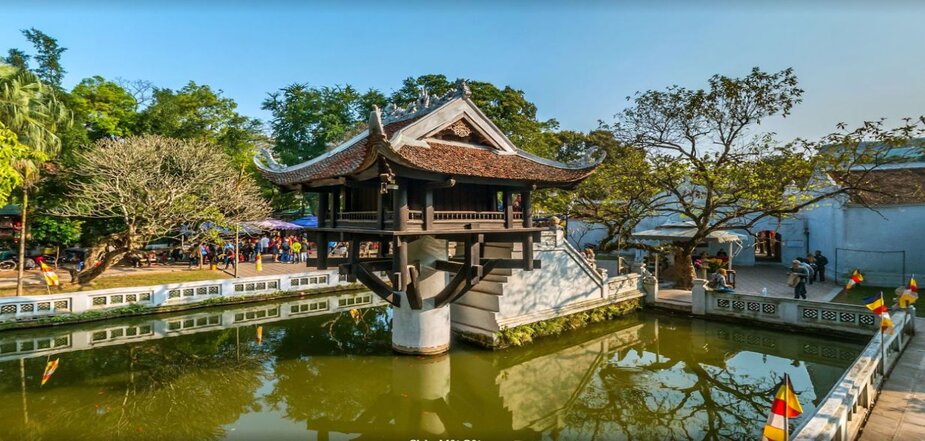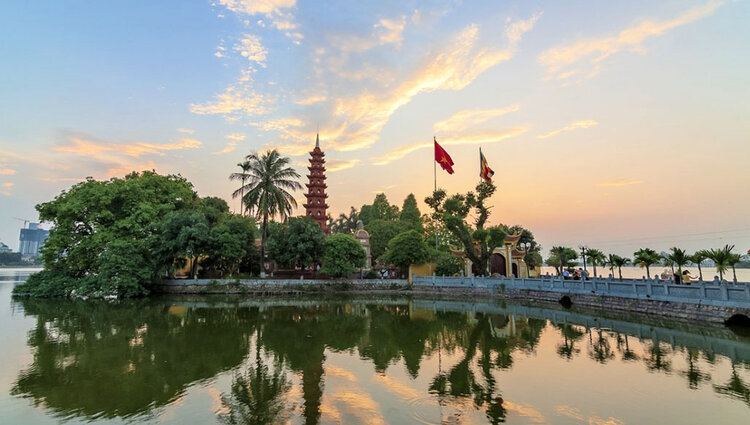1. Overview
Tran Quoc Temple is a Buddhist temple located on the West Lake of Hanoi, Vietnam. It is considered the oldest temple in Hanoi, with a history dating back over 1,500 years. The temple was originally built during the reign of Emperor Ly Nam De in the 6th century and was named Khai Quoc, which means “National Founder.” It was later renamed Tran Quoc during the Tran Dynasty in the 13th century. The architecture of the pagoda has an ancient, golden and ochre color, and the highlight here is the 11-storey lotus tower. Tran Quoc Temple attracts tourists not only for its rich history but also its thousand-year sacredness.
See more:
2. Exploring the Tran Quoc Temple
2.1. About Tran Quoc Temple
Location: No. 46 Thanh Nien, Yen Phu ward, Tay Ho district, Hanoi, Vietnam
Open time: From 7:30 AM to 11:30 AM – From 1:30 PM to 5:30 PM / everyday
Entrance fee: Free

2.2. Transportation to Tran Quoc Temple
2.2.1. By bus:
The bus No. 50, E05 or E09 stop right away at Thanh Nien Street, after getting off the bus, you take a 2-3 minute walk to Tran Quoc Temple easily.
2.2.2. By taxi or Grab:
To take a taxi, you can look for a reputable taxi company in Hanoi, such as Mai Linh or Taxi Group. Alternatively, you can book a Grab ride using the Grab app on your smartphone. Simply enter your pickup location and destination as Tran Quoc Temple, and a Grab driver will pick you up and take you directly to the temple.
2.2.3. By motorbike:
You can use your own motorbike or rent it at your hotel and ride it to the temple quickly and conveniently. However, you should notice that the parking lot is opposite the pagoda, next to an ice cream shop. The parking fee is from 5,000 to 10,000 VND/motorbike.
2.3. Long history of Tran Quoc Temple
According to legend, the temple was originally built during the reign of Emperor Ly Nam De in the 6th century and was named Khai Quoc, which means “National Founder”. It was built on an islet in the West Lake of Hanoi, which was then called Luc Thuy Lake.
During the Tang Dynasty in the 7th century, the temple was renamed An Quoc, which means “Pacification of the Country”. In the 13th century, during the Tran Dynasty, the temple was renamed Tran Quoc, which means “Stabilizing the Nation”.
During the 17th century, the temple was badly damaged by war and natural disasters, and it underwent major restoration in the 18th century during the Le Dynasty. The temple was again restored in the 19th and 20th centuries, with new structures and monuments added.
Today, Tran Quoc Temple is considered the oldest and most sacred temple in Hanoi, and it continues to be an active place of worship for Buddhists.
2.4. The architecture of Tran Quoc Temple
- Total area: up to 3,000 m²
- Main areas: tower garden, ancestral house and upper hall
- Three houses: the front house, the incense burning house and the the upper house
- Other structures: drum tower, a bell tower, and a pagoda
- Highlight: an 11-storey stupa with a height of 15m, at each floor of the tower is placed a white gemstone Buddha statue
- Main colors: golden and ochre color creates an ancient, peaceful, and very historical space
- Style: blend of Vietnamese, Chinese, and Indian styles

2.5. Exploring the Tran Quoc Temple
2.5.1. The 11-storey Stupa (Bao Thap)
As soon as you enter the pagoda, you will quickly see the storey stupa, which is considered the highlight here. The tower is 15m high, including 11 floors. Each tower floor has a precious white stone Amitabha Buddha image in each arched doorway. In particular, on the top is a 9-storey lotus tower carved with precious stones, creating a majestic beauty.

2.5.2. The Front House (Tien Duong)
The Front House was built to the west, this place to worship many beautiful statues and unique mandarins. The most prominent is the statue of Shakyamuni Buddha, made of wood and painted with gold paint. This statue has been voted the most beautiful statue of Nirvana in Vietnam. Along with that are many Buddha statues cast in shimmering bronze.

2.5.3. The Upper House (Thuong Dien)
The Upper House has 14 steles engraved with poems of famous poinsettias and doctors. In addition, the epitaph also provides a lot of information. It fully describes the times of temple building through the kings so that later people know more about the history of Tran Quoc Temple.

2.5.4. The Bodhi Tree
It is the Bodhi tree that is currently being planted at Tran Quoc Pagoda, which Indian President Prasat personally gave to President Ho Chi Minh in 1959. This Bodhi tree originated in Bodh Gaya village, Bihar state, India, where Buddha attained full enlightenment after 49 days of meditation. This is considered a sacred tree in Tran Quoc Pagoda.

2.6. Best time to visit Tran Quoc Temple
If you’re interested in experiencing traditional holidays, visit during Buddha’s Birthday, which usually falls in May, or Vu Lan, which falls in August, or the Lunar month on the 1st and 15th. During these holidays, the temple is decorated with lanterns and flowers, and visitors can join in prayer. On holidays, the temple will be busier and more crowded. However, if you like quiet, you can visit the temple on normal days.
2.7. Tips when visit the temple
Dress appropriately: Tran Quoc Temple is a religious site, so it’s important to dress modestly and respectfully. Cover your shoulders and knees, and avoid wearing shorts or revealing clothing.
Remove your shoes: When entering the temple, you will be required to remove your shoes as a sign of respect. Bring a pair of socks to wear if you’re uncomfortable walking barefoot.
Respect the rules: Be mindful of the temple’s rules and regulations. Don’t touch or climb on any statues or structures, not allowed to pick flowers and keep your voice low while inside.
2.8. Tourist attractions nearby
2.8.1. Hoan Kiem Lake
Hoan Kiem Lake has a deep historical culture in Vietnam, appearing a lot in the poetry of poets. Walking around the lake, you will feel the fresh, cool air and romance.
- Location: Hoan Kiem district, Hanoi, Vietnam
- Open time: 24/24

2.8.2. Temple Of Literature
The Temple of Literature was built in the 11th century and is a place to honor and record writers, teachers, saints, and court officials of the Ly, Tran, Le, and Nguyen dynasties.
- Location: 58 Quoc Tu Giam, Temple of Literature, Dong Da, Hanoi, Vietnam
- Open time: From 8 AM to 5 PM/ everyday

2.8.3. One Pillar Pagoda
The pagoda was originally built in 1049 by Emperor Ly Thai Tong to honor the birth of his son, and it has since become one of the most iconic and recognizable landmarks in Vietnam.
- Location: One Pillar Pagoda, Doi Can, Ba Dinh, Hanoi, Vietnam
- Open time: From 7 AM to 6 PM/ everyday

Thus, Tran Quoc Temple in Hanoi is a completely worthy place for you to experience from culture, history, architecture to sacred beliefs.
In conclusion, Metta Voyage hopes the above information will help you better understand this famous Buddhist place in Vietnam. If you love history and other cultural spots, you can refer to the tour in Hanoi here.
Contact us:
Website: mettavoyage.com
Email: info@mettavoyage.com
Hotline 24/7: + 84 989 383 572



0 Comment